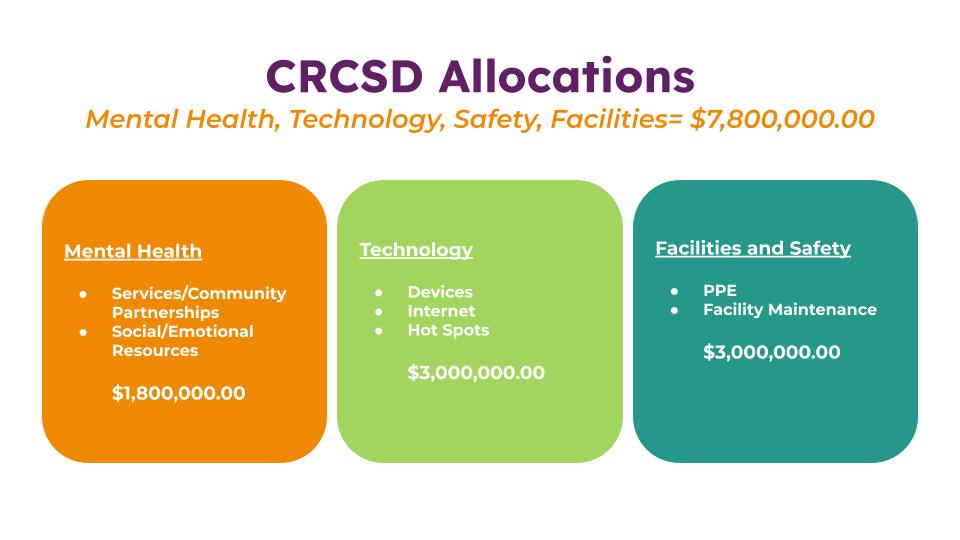On April 21, 2021, the U.S. Department of Education (USED) released its American Rescue Plan Elementary and Secondary School Emergency Relief Fund (ARP ESSER or ESSER III) state plan template for state education agencies (SEAs) to complete to receive the remaining third of ESSER III funds. In addition to the template, the USED also released ESSER III interim final requirements related to SEA consultation, district ESSER III plans, and district plans for a safe return to in-person instruction and continuity of services.
ESSER allocations
ESSER I: $3,078,077
ESSER II: $14,436,004
ESSER III: $32,421,214
Total: $49,935,295
ESSER assurances
To view Cedar Rapids Community School District’s programmatic, fiscal, and reporting assurances for ESSER III funds, click the button below.
ESSER expenditure categories
View the ESSER III expenditure categories below. Of the $32.4 million awarded, at least 20% must go towards recovery of learning.
Focused on learning—$19.80 million
Recovery of learning—added time
$6.89 million (over three years)
• Summer school programming
• Before- and after-school programming
• Tutoring services
Recovery of learning—CORE learning
$7.93 million (over three years)
• Equity
• Instructional practices
• Curriculum
• Professional learning
Acceleration and innovation learning
$4.985 million (over three years)
• Early childhood extension
• High school magnet
• Innovation professional learning

Mental health, technology, safety, facilities—$7.8 million
Mental health
$1.8 million
• Services/community partnerships
• Social/emotional resources
Technology
$3 million
• Devices
• Internet
• Hot spots
Facilities and safety
$3 million
• PPE
• Facility maintenance

Building allocations
Recovery of learning—CORE area ($4.8 million)
Parameters
- Aligned to building school improvement plans that are aligned to Office of Learning and Leadership goals, which are aligned to strategic plan system indicators
- Plan to build capacity of staff in building
- Goal must address equity gaps in Reading and/or Math and Social-Emotional Learning (SEL) competencies
- When schools utilize the funds
- What schools utilize funds for aligned to equity gaps and SEL competencies
- What students that schools target
Key goal areas that are best practices for learning loss recovery CRCSD is aligning work:
- Improved instructional practices in classrooms (staff)
- A district- or school-wide high-dosage, one-on-one tutoring program (student)
- Additional in-school strategies to remediate student learning loss include adding time to learning, looping, creating individualized learning plans, and cross-grade collaboration (student)
- Integrating school-day classroom instruction into after-school curricula (student)
- Creating and expanding community partnerships helps districts create and implement cost efficient programs such as one-one-one tutoring, after-school programs, and summer learning (student)
Please reach out to the contact below if you need this plan provided in a different format or read aloud.